TRX Suspension Training: Building Core and Major Muscles Strength
Here’s how Masters swimmers can use TRX suspension training to build strength
This article is one of a three-part series on suspension training:
- Suspension Training: Functional Strength Workouts Get You Race-Ready at Home
- Suspension Training: Improving Flexibility and Balance
Suspension training can enhance athletic performance for swimmers in a variety of ways, including by improving flexibility and joint range-of-motion, muscle strength and power, and balance. Gains in these components can translate to more efficient and powerful swimming.
Suspension training requires only your body weight, supported by a web strap at varying angles, to facilitate each exercise. Relying on the suspension trainer to support your weight can take some getting used to, especially if you’re balance-insecure.
Grip the handles and lean back from the anchor close to upright at first. Get used to letting the strap support you until you feel comfortable with it before embarking on a full workout. Stand with your feet wider apart if you feel more comfortable with a more secure base of support.
Perform two to three sets of 10–15 repetitions of each of the following exercises. Make sure to inhale and exhale during each repetition. Always end a set if your form starts to disintegrate.
Squat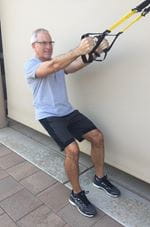
Objective: strengthen quadriceps, hamstrings, and glutes
Adjust the straps to medium length and stand facing the anchor. Grip the handles and sit back away from the anchor until there’s no slack in the straps and your arms are nearly fully extended. Begin a series of squats, keeping your toes and knees tracking forward and make sure your knees never extend beyond your ankles as you squat and then drive back up to vertical. Avoid locking your knees at the top of the squat. If you have knee problems, reduce the depth of the squat and/or place your feet closer to the anchor so you can unload more of your weight onto the strap and use your upper body to assist.
For variations, try a single-leg squat with one leg extended to add a balance component or alternate a squat with a row. You can also perform jump squats to improve explosive power, but only do this if you’re on grass, dirt, or suspended wood or rubber flooring to allow for safe impact.
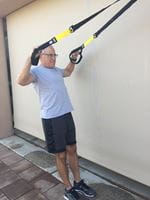 High Row with External Rotation
High Row with External Rotation
Objective: strengthen upper trapezius and external rotator muscles
Adjust the straps to the shortest setting and stand facing the anchor. Vary your distance from the wall to achieve an optimal amount of resistance. It’s more difficult the closer your feet are to the anchor. Grip the handles and lean back so that the suspension trainer supports you completely and there’s no slack on the straps. Lead with your elbows, keeping them high, without raising your shoulders toward your ears, your palms facing down. Pull back until your elbows reach or come slightly behind your shoulders, retracting your shoulders as you move back, and then open your hands upward until they are over your elbows to externally rotate. Keep your wrists level. Lower your hands and then lengthen your arms back out.
Lengthen the strap to perform mid- or low rows for the middle and lower trapezius. Try single-arm rows to increase difficulty. To add a balance component, raise one leg from the ground while performing any row activity, if you can do so safely.
Tricep Extensions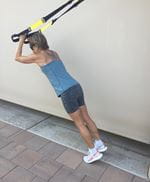
Objective: strengthen triceps muscles while improving shoulder girdle stability
Adjust the strap to medium length and stand facing away from the anchor. Grip the handles and start with your arms extended in front of you, leaning away from the anchor point so the web straps are tense and completely supporting your weight. Allow your weight to tip even farther forward as you bend your arms, keeping them parallel to each other so triceps rather than pectorals are activating, and then extend arms back out to the starting position.
If you’re experiencing elbow pain that would be irritated by repeats like this, drop into the triceps flex and maintain an isometric contraction for 20 to 30 seconds, continuing to breathe.
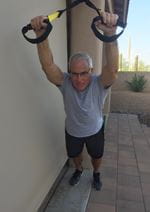 Plank with Overhead Arm Raise
Plank with Overhead Arm Raise
Objective: strengthen core muscles and stretch and strengthen shoulder girdle
Adjust the web straps to the shortest position and stand facing away from the anchor point. Grip the handles and extend your arms out in front, leaning away from the anchor point, until the straps are tense and supporting your body weight. Keep your hips level. Now gradually raise your arms overhead, staying engaged in your core without arching your back, before lowering them to the starting position again. If you have difficulty maintaining proper alignment, start with your feet farther away from the wall until you’re strong enough to perform this exercise bearing more body weight.
Plank
Objective: strengthen rectus and transverse abdominals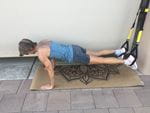
Place a mat perpendicular to the wall so that you’ll have hand and knee cushioning during this exercise. Adjust straps to a long (mid-calf) length. Place your right foot in left cradle and your left foot in right cradle and flip over on your stomach. Keep your hands underneath your shoulders and stay engaged in your shoulder blades. Be mindful of your lower back in the extended position, making sure your belly is lifted and there’s no sag in your lower back that could cause lumbar irritation. Perform two to three sets, holding your isometric plank for 30–60 seconds.
You can also try some crunches or pikes from the plank position to target the rectus and transverse abdominals.
If your wrists bother you in a normal plank position, try coming down to a forearm plank. A kneeling plank is another option.
Plank to Tuck
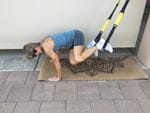 Objective: strengthen internal and external obliques
Objective: strengthen internal and external obliques
From the plank position, rotate toward the right, tucking knees in toward your chest before extending back out into full plank position and then rotate and tuck in toward the left.
Categories:
- Technique and Training
SIGN UP FOR UPDATES FROM USMS














